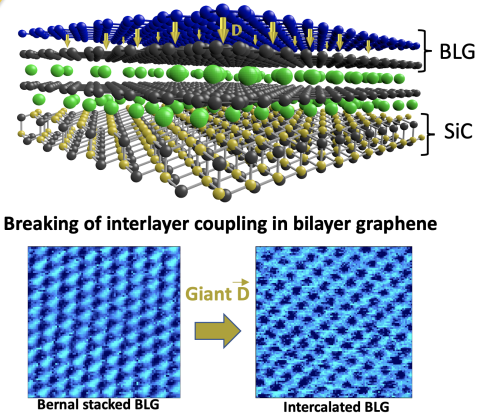Scientific Achievement
Gd intercalation introduces an exceptionally large transverse displacement field acting on the overlying Bernal - stacked bilayer graphene (BLG).

Significance and Impact
Metal intercalation is a robust and reproducible synthesis technique for creating novel electronic 2D graphene-based quantum materials. Their properties can be controlled by inducing a giant displacement electric fields inaccessible with standard double gating in BLG devices.
Research Details
- Controlled synthesis to form a high-quality graphene-rare earth heterostructure (green balls, top panel) to intercalate under the top Bernal stacked BLG.
- Local modification of the band structure is seen in scanning tunneling microscopy maps that show 6-fold symmetry of the unit cell, which is a trademark of single layer graphene (RHS bottom panel).
4-probe electronic transport and low energy-electron diffraction are used to characterize the sample globally. - The transport is purely 2-dimensional because the heterostructure decouples from the substrate.
M. Kolmer, W. Ko, J. Hall, S. Chen, J. Zhang, H. Zhao, L. Ke, C.-Z. Wang, A.-P. Li, and M. C. Tringides, “Breaking of Inversion Symmetry and Interlayer Electronic Coupling in Bilayer Graphene Heterostructure by Structural Implementation of High Electric Displacement Fields.” J. Phys. Chem. Lett. 2022, 13, 11571−11580 (front cover)
